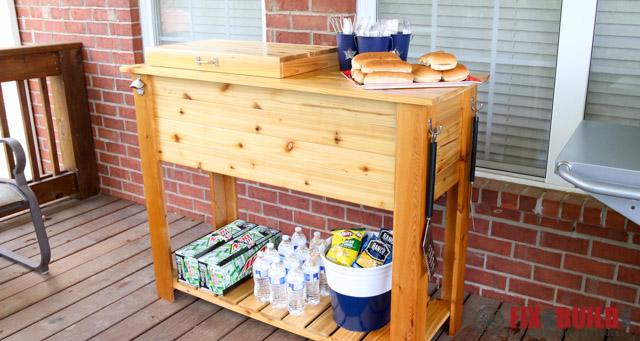
Today I’m going to show you How to Build a DIY Patio Cooler Cart with space for grill accessories. Two things I’ve been thinking of building are a patio cooler and a grill cart. Since my back deck is not huge I decided to kill two birds with one stone and show you guys how to make a DIY cooler box and BBQ cart in one.
The project is made from cedar to withstand the elements and give it a nice classy look. At the heart of the wooden cooler box is a 48 qt cooler with plenty of capacity for your parties. The lid for the storage box is flush with no hinges or handles giving you a 22″ x 20″ landing space for food and other barbecue fixings. Assembly is easy and straight forward using the available plans. So read ahead and get ready to get your summer outdoor entertaining game on point!
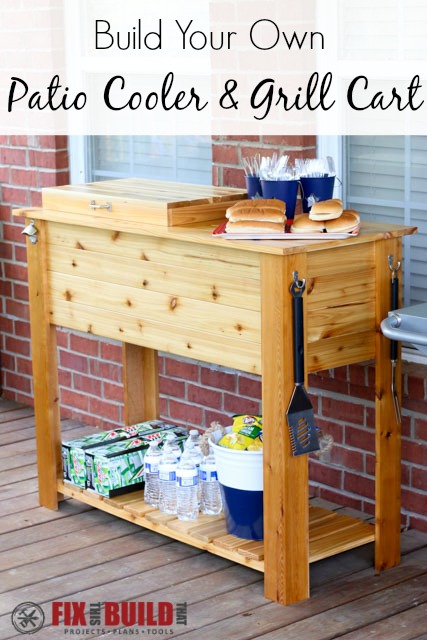

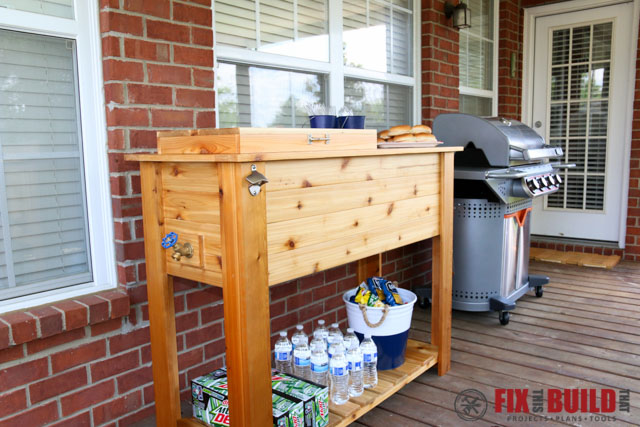
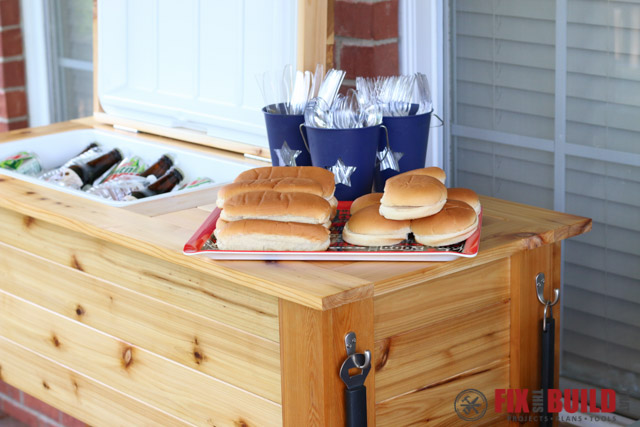

Tools Used
- 12″ Dual Bevel Miter Saw
- 18v 5pc Toolkit
- Compact Router
- 18v Brad Nailer
- Oscillating Spindle Sander
- Pocket hole jig
- Tablesaw (or circular saw)
Materials/Supplies
- (13) 12′ 1×4 cedar boards
- 1-1/4″ Pocket Hole Screws
- 1-1/4″ Exterior Screws
- 48qt Cooler
- 3″ utility hinges
- Front handle
- Bottle Opener
- Single Hooks
- Hose Bib
- PVC fittings
Affiliate links are used on this page. See my disclosure page for info on affiliate programs.
How to Build a DIY Patio Cooler Box
- Build the cooler base
- Make grill storage bay and shelf
- Build the patio cooler lid
- Install cooler drain and lower shelf
- Finish and add hardware
I built the cooler box and grilling station entirely out of 1×4 cedar. My local lumber supplier had 12′ boards that were rough on one side and I was able to get them for half the price of what you would pay at the big box store for the cedar 1x4s. If this is an option for you then you can save some significant money going this route.
1. Build the Patio Cooler Base
Build Frame and Legs
You’ll start by building the top frame based on the size of your cooler. The top of my cooler was 23-3/4″ x 13-1/2″. If your cooler is a different size then you’ll need to adjust the top frame accordingly and see if you need to adjust the base as well.
First cut 2 boards to 50″ for the long top frame pieces and 3 boards to 13-1/2″ for the short top frame pieces. Drill pocket holes in the ends of the short pieces and assembly with 1-1/4″ pocket screws. This will give a 15-3/4″ opening for the grilling storage box.
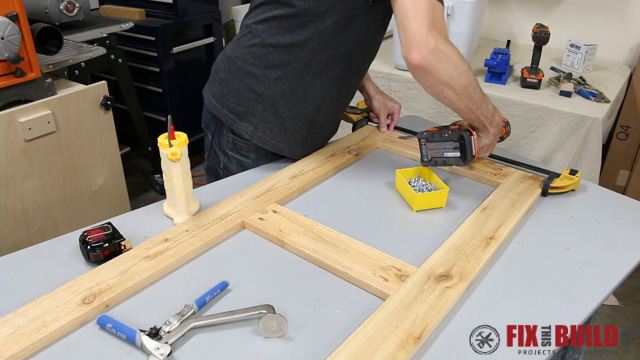

Next cut 8 boards down to 38-1/4″ long for the legs. Rip down 4 of these boards to narrow leg pieces at 2-3/4″ wide. Use a pocket hole jig to drill pocket holes in the 2-3/4″ pieces in the top 13″ of the leg and another hole 2″ up from the bottom.
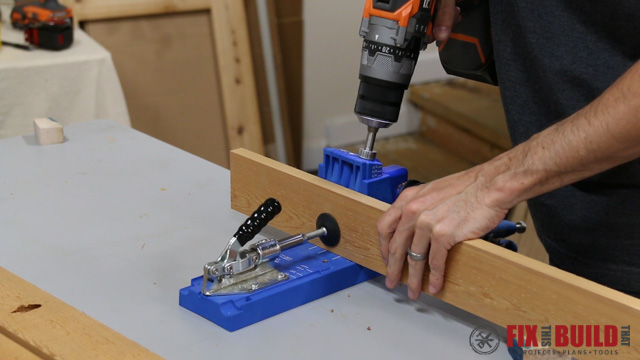

Join the narrow leg pieces to the wide pieces glue and 1-1/4″ pocket hole screws on the top and bottom. In the gap where there are no pocket holes, use clamps to hold the joints tight. Make two legs with the narrow pieces on the right side and two with the narrow pieces on the left side. This lets you have the wide face of the legs showing on the front and back of the patio cooler cart.


Finally, cut 8 pieces of side cladding to 16-1/2″ long. Use a trim router to route a 1/16″ 45 degree chamfer on the outer edges of each board. This will give the boards a nice beadboard look when butted together.
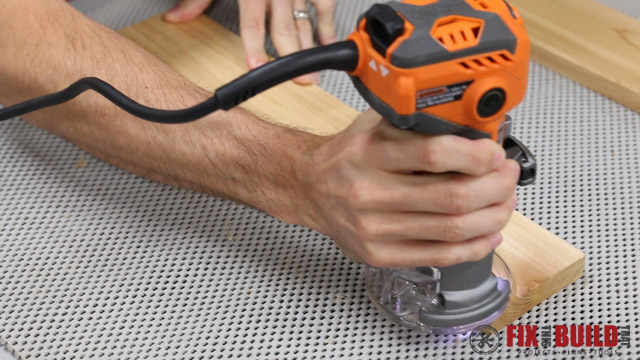

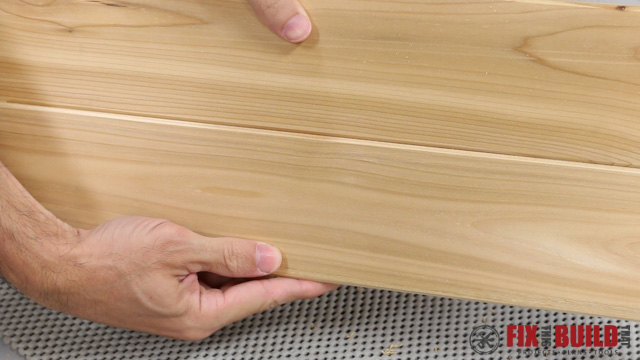

Connect Legs with Side Boards
Lay two legs down and starting from the top, attach 4 side cladding pieces to the legs with two 1-1/4″ screws on each side of each board. Repeat this process with the other 2 legs to form 2 side assemblies.
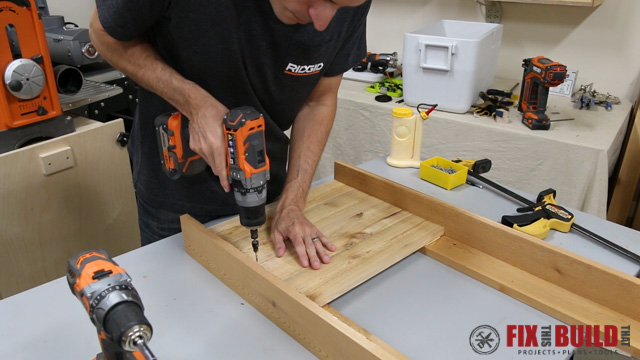

After that, cut 4 pieces of front cladding and 4 pieces of back cladding to 44-1/2″ long, and route a chamfer on the long edges just like the side cladding. Side the side assemblies on edge and starting at the top, attach the front cladding to the sides with 1-1/4″ screws.
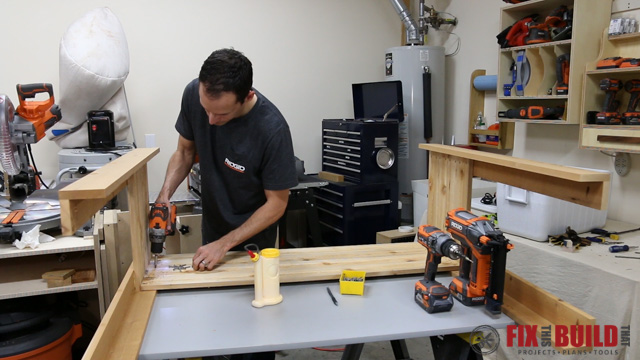

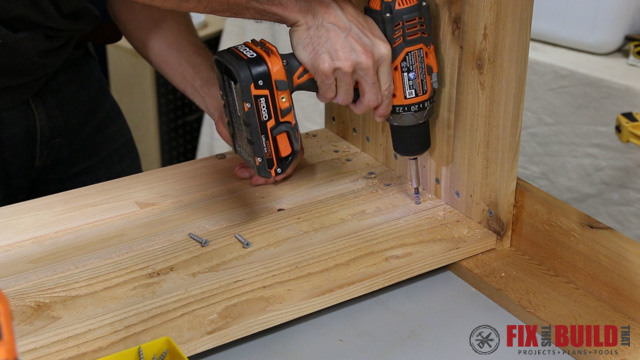

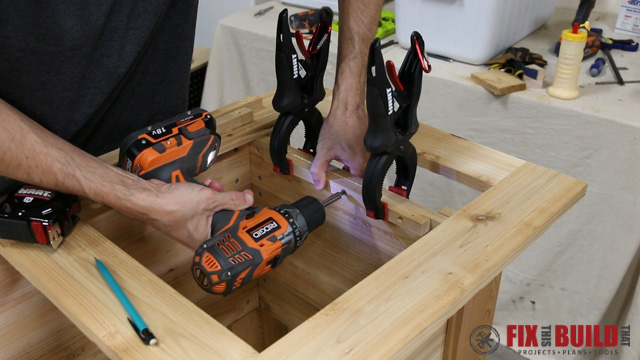
2. Make the Grill Cart Storage Bay and Bottom Shelf
Attach two 1″ wide 14″ long cleats to the inside of the front and back walls, 18″ from the right side. Cut four 15″ wide storage divider boards and glue and screw them to the cleats to create the storage bay on the DIY cooler box.
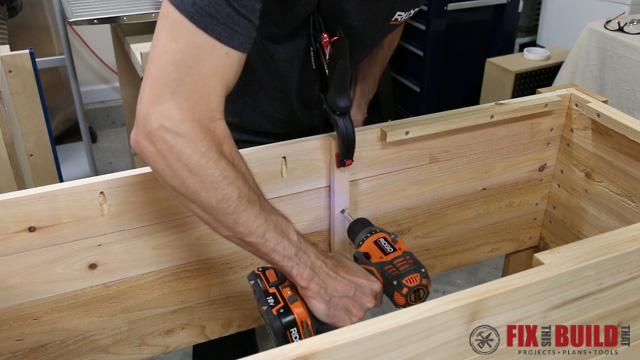

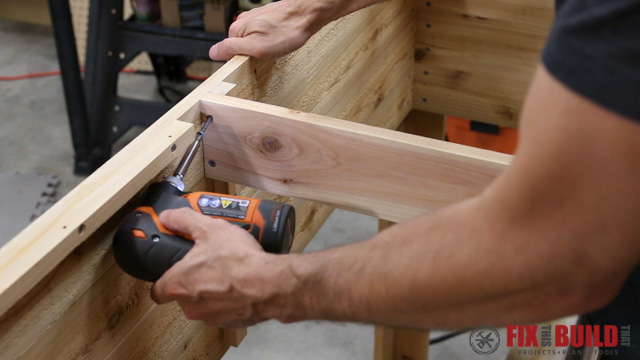

Cut and install two 17-1/4″ cleats to the front and back of the storage bay. Put them 3/4″ up from the bottom of the bay then attach five 15″ storage bay bottom pieces to the cleats with screws from underneath. The middle board will need to be trimmed to fit since it’s smaller than the others.
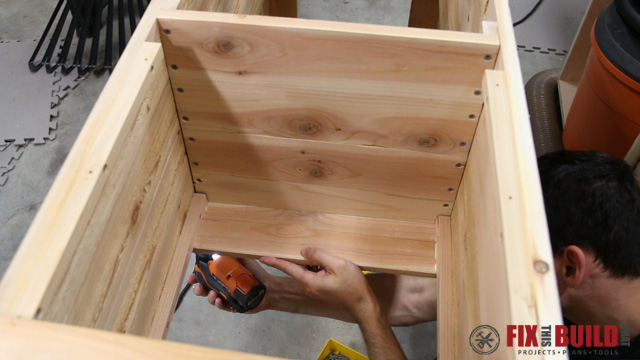

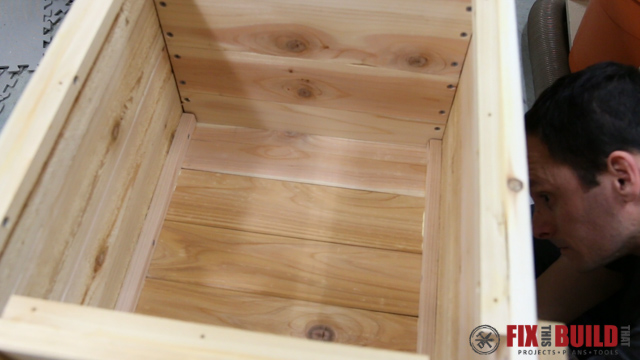

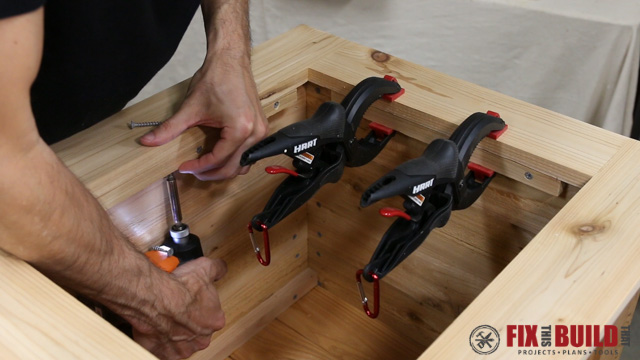

Cut two 46″ long 1″ wide shelf stretchers and eleven 16-1/2″ shelf slats. Attach the slats to the stretchers with glue and a brad nailer. For consistent spacing start with the outer slats and then secure the middle slat. From there fill in the gaps spacing the slats ~3/4″ apart.
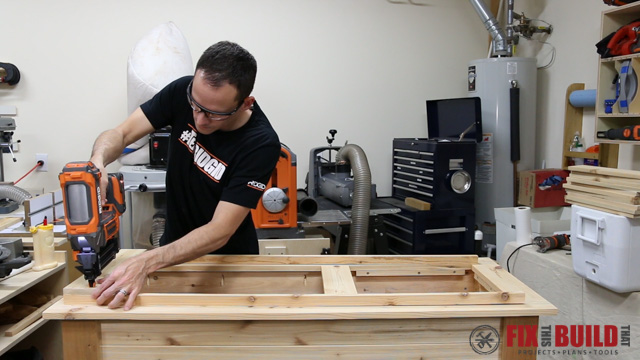

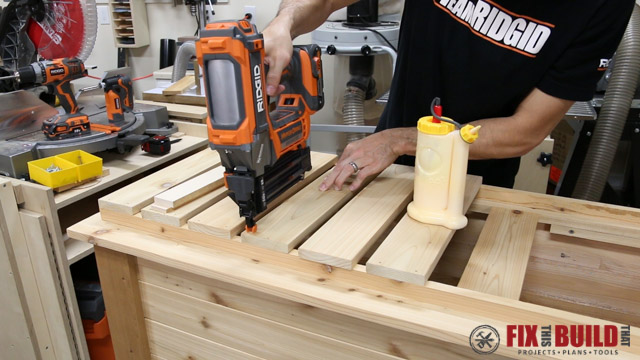

Test fit your cooler in the opening and remove the cooler drain plug since you’ll need it later. Then reach a marker through the cooler drain and mark a spot on the left side of the patio cooler. Drill a 1-1/4″ hole in the side for the plumbing fittings.
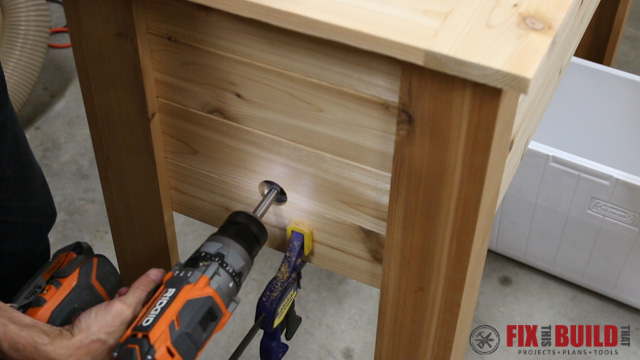

Flip the grill cart combo over and put the cooler in place. Secure the cooler by installing three 15″ cooler supports into the front and back with 1-1/4″ pocket screws.
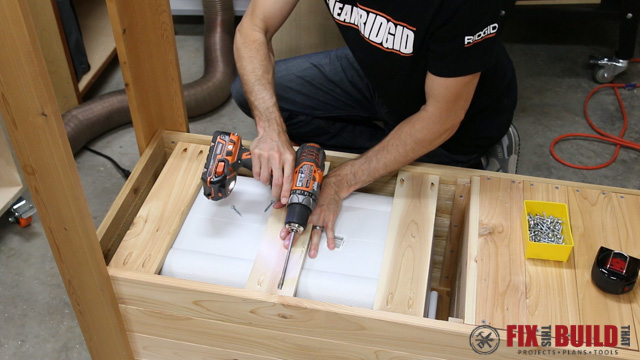

3. Make the Patio Cooler Box and Grill Bay Lids
Grill Bay Lid
Flip the DIY patio cooler back over and cut four 15-3/4″ long storage bay lid pieces. Put a chamfer on the boards with the trim router like the body cladding. Drill a 1″ hole in the middle of one board and chamfer the top edge of the hole.
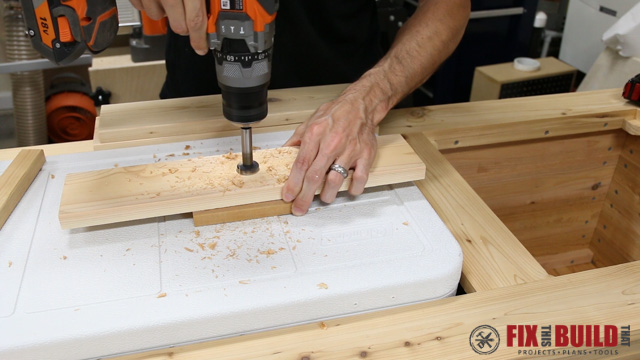

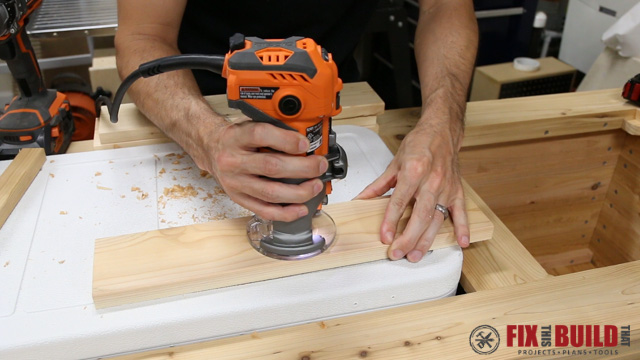

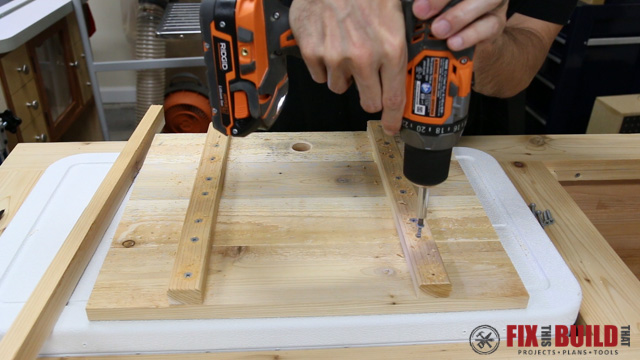

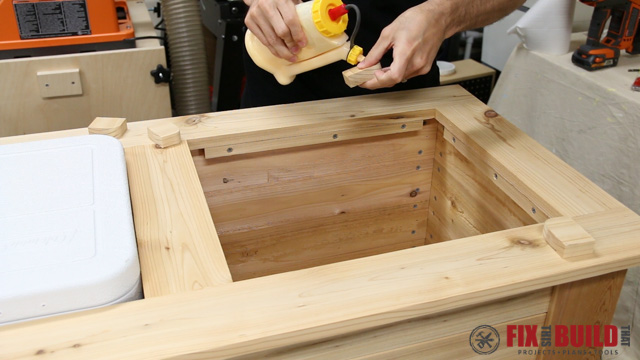

Cooler Box Lid
Build the frame around the cooler lid based on your own cooler measurements. The sides should be 3/4″ taller than your lid. I cut two lid front/back pieces to 25-1/4″ by 2″ and two side piece 13-1/2″ by 2″. Join the frame with 1-1/4″ pocket hole screws.
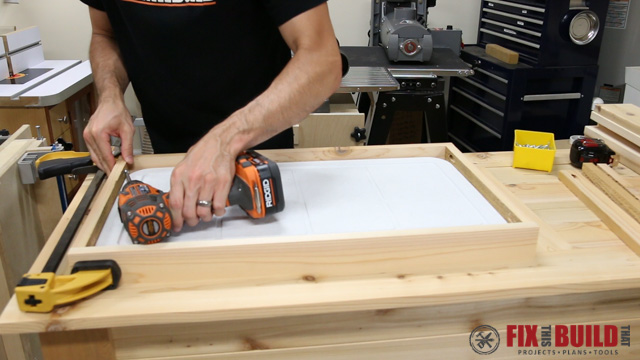

Cut 3 lid support cleats to 13-1/2″ by 1″ and attach them to the front and back with pocket holes. Place the outer cleats so they are directly over the side ridges on your lid that mate with the cooler body. You’ll be screwing into the lid later and don’t want the screws to pop through the underside of the lid.
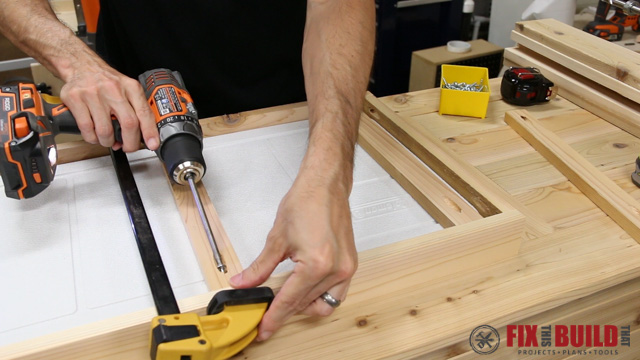

Then make 5 lid top pieces out of 25-1/4″ boards. Route the 45 degree chamfers on these boards just as the others. Layout the boards on the top and cut the center piece to width to fit. Use super glue and temporarily affix the full size boards to the edges of the frame.
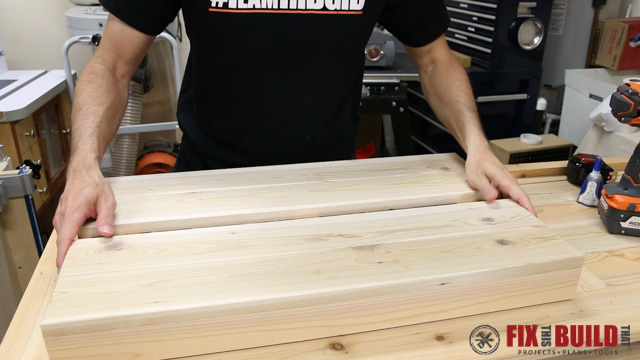

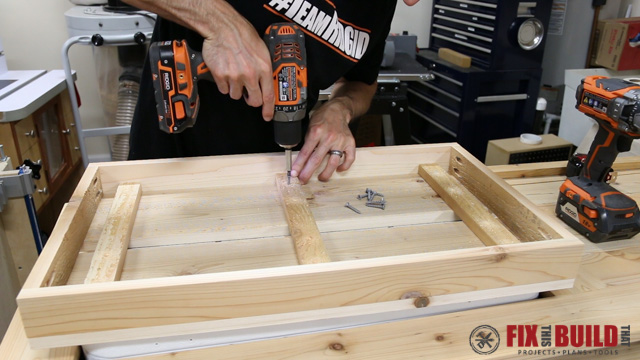

Flip the lid over again on top of the cooler. Now secure the top to the cooler lid with 1-1/4″ screws through the outer cleats into the lid. Attach the center board with wood glue on the center cleats and super glue on the outer edges. The super glue will bond quickly and the wood glue will give a long lasting hold. Assembling the lid this way give you a super clean look with no nail or screw holes…SCORE!
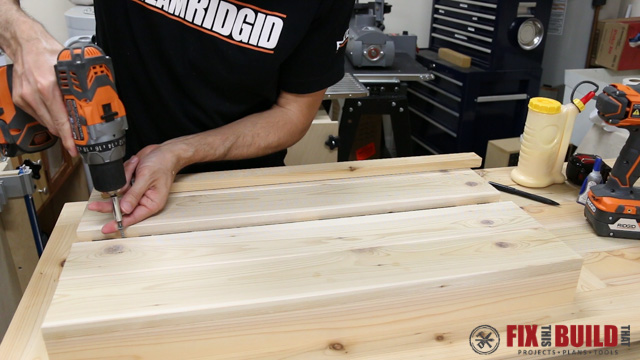

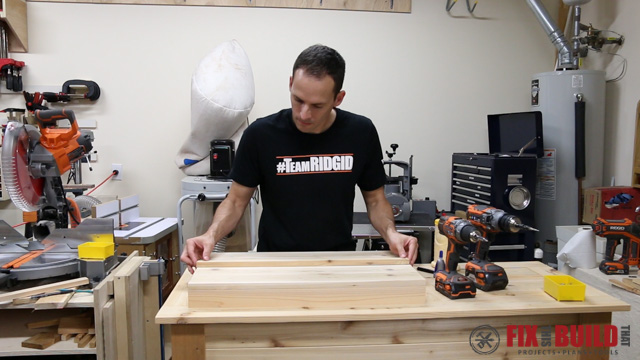

4. Install the Cooler Drain & Lower Shelf
Remove the drain from your cooler and keep the washer on the inside. Get two 1/2″ PVC male threaded adapters, a length of 1/2″ PVC, a 1/2″ nut and a hose bib for the outside of the cooler.
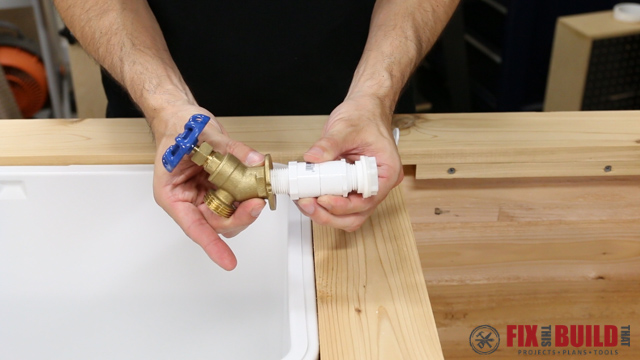

The length of the PVC pipe will vary per installation. Cut a hose bib mounting block to 3-1/2″ by 3-1/2″ and drill a 1″ hole through it for the male adapter. Glue up the final PVC parts and install them on the hose bib and mounting block. Then install them into the cooler box and lock in place using the nut in the cooler.
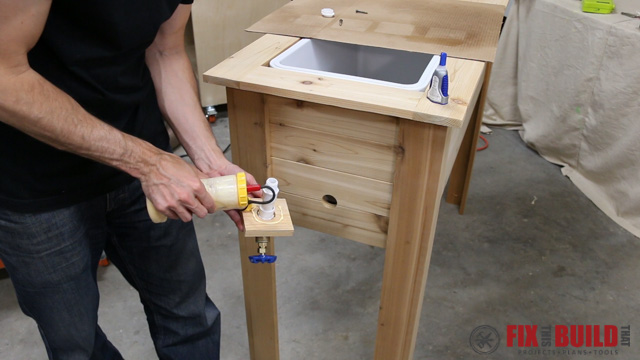

Sand everything down to 150 grit and apply your finish at this point. I used a Spar Urethane made for outdoors so it will wear well.
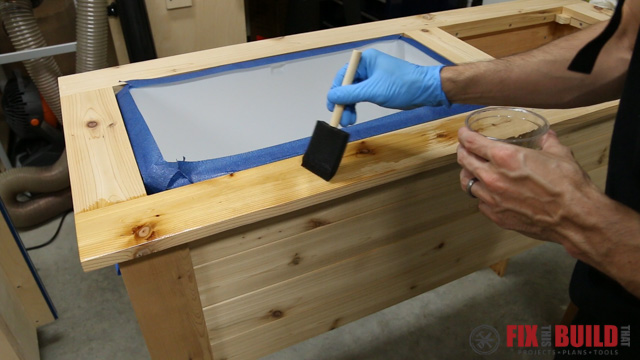

After the finish is dry, install the lower shelf so the bottom is 2-1/2″ up from the floor. I would recommend turning the patio cooler on it’s top to do this vs. laying it on its back like I did 🙂
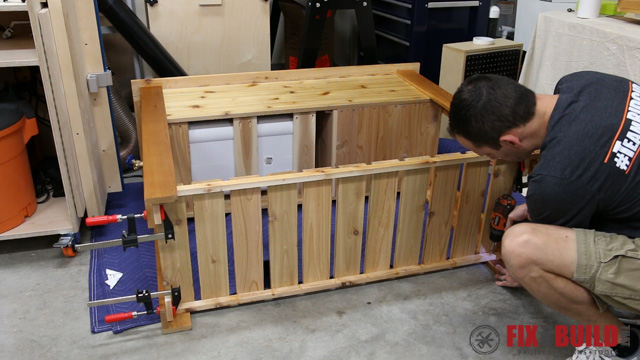

5. Add Hardware to the DIY Patio Cooler Cart
The cooler lid gets 3″ utility hinges and a handle on the front.
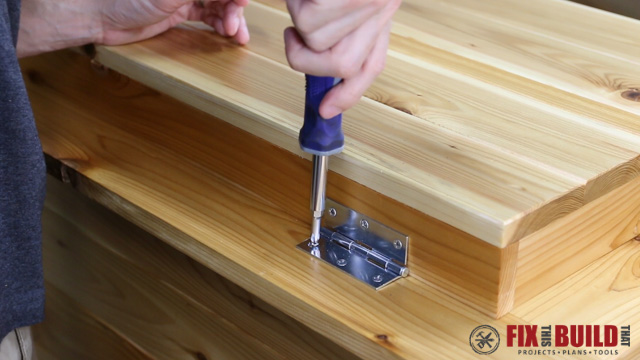

I added a bottle opener on the front and 2 hooks on the grilling side of the cart as well.
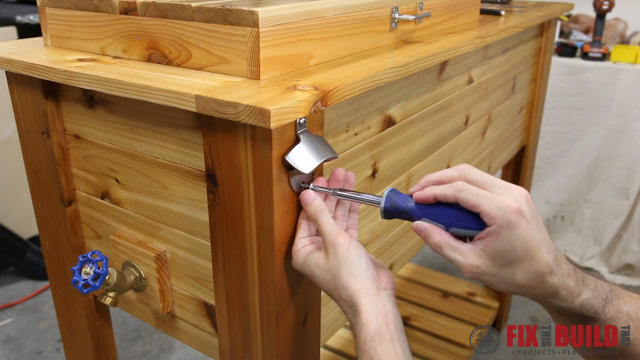

Then I put some grilling accessories into the storage side and it worked great to hold them all. I just put some little dividers in there to keep them separated. And if you need help picking the right grilling and barbeque setup for your backyard, check out this helpful article from Porch.com.
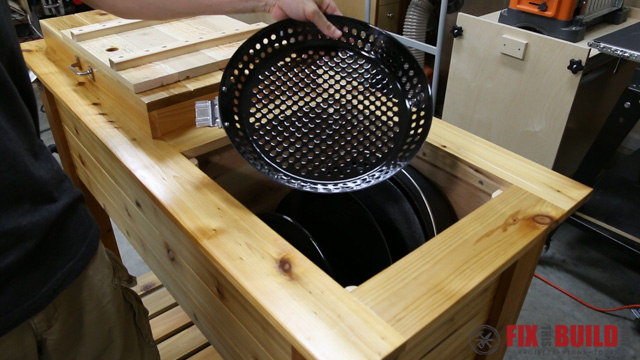

RIDGID provided me with product and/or monetary compensation as a sponsor of this build. All opinions are my own and are not filtered by the sponsor.

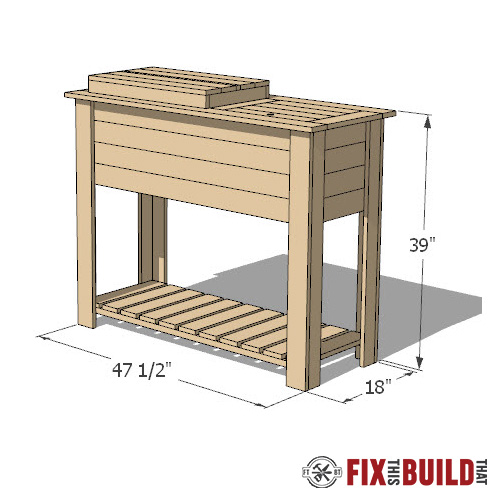

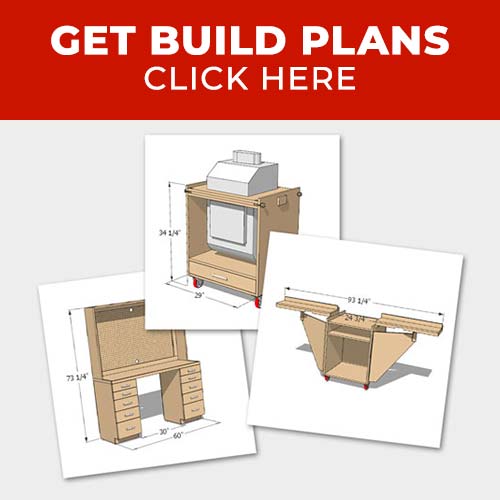
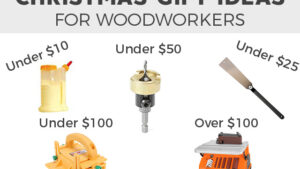

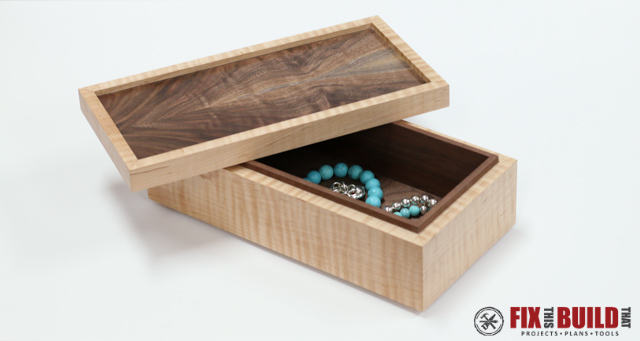
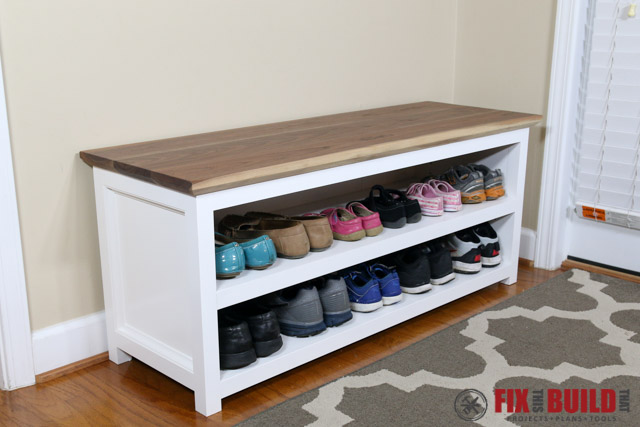
How many 8′ cedar boards would it take to complete this project? My home store doesn’t sell 12′ boards.
I made this over a weekend for a Father’s Day gift for my husband. This is the very first woodworking project I have ever done. The plans are great and details out everything you need to do. Thanks for making this easy!
I’m trying to find a 1/2″ Male PVC Adapter that fits though the 1″ hole on the mounting block, and the 1″ hole on the inside of my cooler. Also, as Ronnie Craig mentioned, I’m having trouble finding a 1/2″ PVC nut. Can someone provide links to these items? Thank you.
What length brad nails did you use? I’m assuming 1.5″? Hoping to start this project in a couple weeks. Thanks!
Having a hard time locating a 1/2 inch pvc nut. Could you point me in the right direction?
Me too!
Greetings,,, Thanks for the plans,,, I altered yours but by not build the grill storage section,,,, and I used a little different design for the top. Was my 1st try at all pocket screws and that worked very well,,, I installed Casters so I used some screws on the bottom for added support… Mark
my first detailed project so i really enjoyed it. did a few things differently. on the front wall we made a wine rack that went into the storage area. the top of the storage area is going to be a cutting board for limes, etc. I also dont own a table saw so i really had to MacGyver the cooler lid lol. ill post pics of mine shortly
awesome! definitely share some photos
Hi Brad, Working on a build now and using your instructions, My question is, I am using kiln dried whitewood and I will be taking this to our camp. Any suggestions on how to treat the bottom of the legs? The unit will be covered but the feet will be sitting on carpet outside out camper. is there any way to seal the legs so the water/rain does not seep up through them?
It’s taking me a while, but slowly working my way through this. Can’t wait to have it finished. One thing I’m doing is priming (oil-based, exterior stuff) and painting. Will post pictures of the final product if I ever finish.
Has the cedar separated much since it was built? Did you glue and screw cleats across separate boards or only use glue on the cleats on the same board?I am thinking of making a build in a similar manner for an elevated/raised garden and wondering about any separation that might occur and if cleating across 3 boards would help or hurt, and if Pocket Holes holding the boards together (front 3 boards) would be a mistake with any possible shrinkage.Thanks…wonderful Piece and instructions.
The cedar has not separated at all (or at least isn’t now). I built it in the summer so I would expect it to shrink if anything in the winter. I did a cleat across the front boards with just 1 screw in the center of each board. This setup will allow the boards to shrink in the winter at their edges. The key though is to use wood that is dried well before hand and has stable moisture content.
thanks for the feedback. I thought of possibly joining the boards together via pocket holes to form the larger panel but that would be a mistake, especially for something outdoors. If there is any shrinkage, I am guessing it would be minimal and having a cleat would be sufficient.
Just bought the plans – Very excited to get started! I am having a tough time finding a 1/16″ chamfer bit. Do you have a go-to place to source something this small? Is there any other bit that might work for this accent?
Jonathan, it’s a little confusing I know. The chamfer bit is just a full sized 45 degree chamfer bit. The 1/16″ is how far you stick it out of the router base. No need for a special bit.
That crossed my mind! Thanks for the clarification!
I’m just about done with the build stage (just have the cooler lid to go) and am wondering, did you spar the underneath and non showing parts? I used cedar as well.
I did not do the inside cavities just because I used oil based and didn’t want the off gassing in the storage part. But I did all the other surfaces. Can’t wait to see your build!
Love this. Question: If I use whitewood or anything cheaper than the cedar, and I make sure to treat it to stand up to weather, am I really that bad off in the elements?
Thanks, Dave! Any wood is going to wear in the elements. If you seal whitewood with an exterior finish and stay on top of it when it starts looking rough then you’ll be find. No different than thinking about a deck made from pressure treated pine.
Much appreciated. Thanks.
Whoo hoo!! Great build! Thanks for the video tutorial and great plans. I’m about 2/3 through building a cooler chest from a different plan, but will be able to use your idea for the lid and spigot on my build. You rock!
Awesome! Tag me if you post it on social media. And thanks!